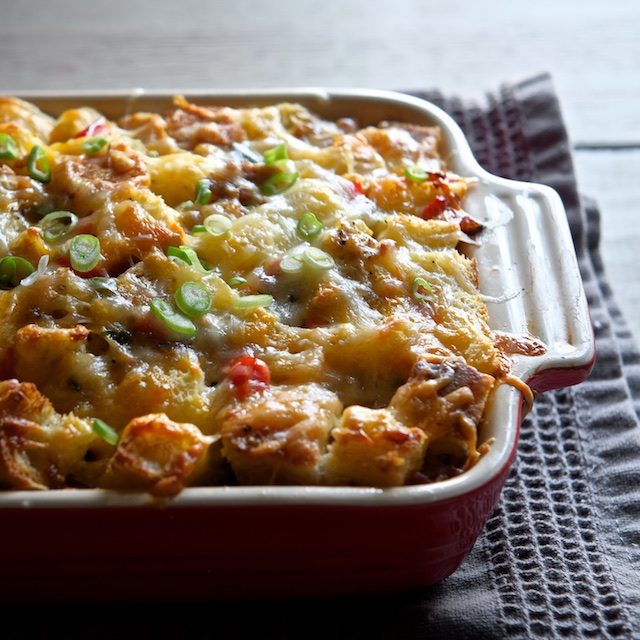
Last week we deconstructed french toast. This week I want to talk about bread pudding. Bread pudding is literally the casserole version of french toast, so for brevity’s sake I’m going to refer you that post for my reasoning on milk and custard ratios. Bread, on the other hand, behaves differently in casseroles and requires a bit of further discussion.
The Bread: Some people will probably disagree, but in my opinion, chewy/crusty bread works really well in french toast. The extra crispy surface area and relatively short soak time make for a rich french toast with good textural contrast. BUT chewy bread DOES NOT WORK in bread pudding. You get that crunchy top layer, yes, but the lower layer soaking in milk and egg turns the over-developed chewy bread gluten into paste. Chewy, gummy, sticky paste. It is UNPLEASANT. I highly recommend choosing a soft, delicate bread for bread budding – one that will practically melt into the custard.
The Custard: I like simplicity, and it turns out the ratio of egg to half and half used in our french toast works really well for bread pudding too. That’s one egg to 1/2 cup half and half. You can add sweetener for sweet versions of bread pudding, or salt and pepper for savory takes.
The Vessel: Go for something with straight vertical sides – round, oval, or square at the base doesn’t matter. The size is important though, because it will determine how many people you can serve, how much bread you need, and how much custard you need. You will need enough cubed bread to fill the casserole dish, and enough custard to saturate all the bread and fill the dish (meaning there will be an actual liquid level after saturating the bread) about half of the way up the side of the dish.
The Extras: Go with breakfast stuff for savory puddings: sausage, cheese, and veggies are my favorites. For sweet versions choose fruits, nuts, and even cheeses or chocolate. But really, use some additions, or you’re in for a boring meal. I also recommend pre-cooking anything raw to keep any water released from messing with the custard.
The Rest: Even more than french toast, bread pudding needs time to rest and evenly distribute the custard through the bread. I recommend a minimum of two hours, but overnight works best if you’re planning on serving bread pudding for breakfast.
The Cook: Low and slow in the oven is the best way to cook bread pudding, covered for the first 3/4 of the time, and uncovered at the end to crisp the top (with an optional finish under the broiler for extra browning). The exact time will depend on the size and depth of the dish you use, but plan on at least an hour of bake time at 325F. The best way to tell when the casserole is done is to insert a knife near the center of the pudding, when the knife comes out clean, the pudding is done.
The Last Bread Pudding Recipe You’ll Ever Need
Ingredients:
-soft bread, cubed (like challah or white bread, enough to fill your casserole dish)
-eggs (about one per cup and a half of cubed bread – eyeball it)
-half and half (1/2 cup per egg)
-flavoring for custard (about 1 Tbsp sugar per egg for sweet (plus a pinch of salt), 1/4 tsp. salt per egg for savory)
-extras (fruit, nuts, chocolate etc. for sweet, sausage, bacon, cheese for savory (amount not important as long as it all fits in your casserole dish))
-butter, for the casserole dish
Method:
1. Cook your extras if necessary and set them aside to cool.
2. Butter your casserole dish and cube your bread.
3. Fit a solid single layer of bread cubes in the bottom of your casserole dish, then layer in filling, cover with more bread and top with a little bit more of the filling (so people know what’s in it).
4. Mix up your custard using a blender or a whisk, and add sugar or salt and any optional spices.
5. Pour your custard over your assembled casserole, being careful to saturate all the bread cubes at the top of the casserole, and make enough that the dish is about 1/2 full of custard (much of which will be absorbed while it rests).
6. Cover the unbaked casserole tightly with plastic wrap and let it rest in the fridge for at least two hours and up to overnight.
7. Remove plastic wrap from casserole, replace with foil, and bake in a 325F oven for at least 45 minutes. Then uncover the casserole and bake at least 15 minutes more, or until the custard is set and a knife inserted in the center comes out clean. Let the bread pudding rest for about 10 minutes before serving.
*The photo on this post is a savory bread pudding with cheddar cheese, breakfast sausage, bell pepper, jalapeño, onion, and green onion on top. I cooked the bell pepper, jalapeño, onion, and sausage beforehand, layered it up with cheese and bread, poured on the custard, and baked it. Easy.
[…] The Last Bread Pudding Recipe You’ll Ever Need. Did you know that most breakfast casseroles are just bread pudding in disguise (frequently named […]
Six Make-Ahead Recipes for Christmas Morning | Sweet Salty Tart — December 23, 2015[…] and method on The Kitchn. Amidst my page of notes from various sites, I used the baking time from Sweet Salty Tart. (She suggests baking the bread pudding 3/4 of the time covered, 1/4 of the time uncovered.) It […]
Gluten-Free Pumpkin Bread Pudding - MI Gluten Free Gal — December 2, 2016